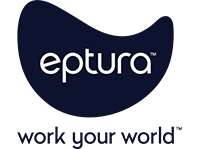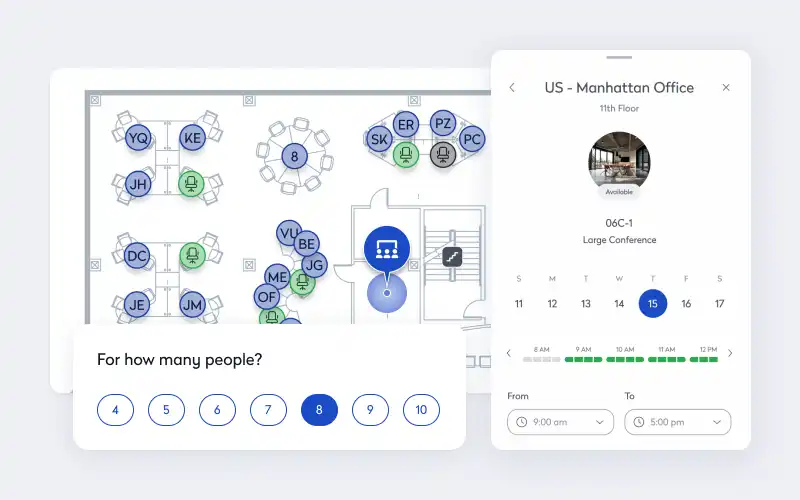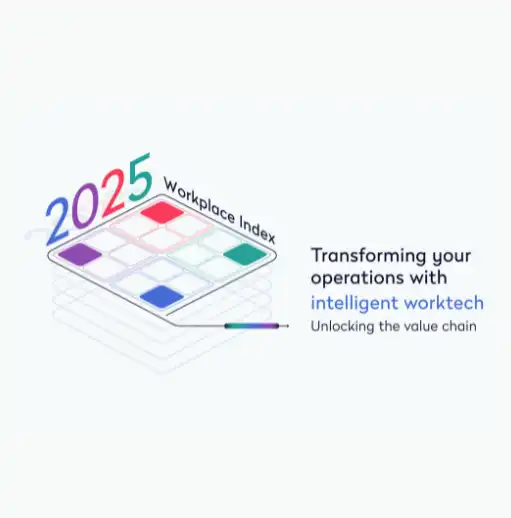
Visitor numbers have nearly doubled across all regions over the past three years, and desk bookings for more than three days a week have increased year-over-year, according to the 2025 Workplace Index report. The current and coming rise in office attendance, especially among new or infrequent visitors, means facility and workplace leaders need clear signage and consistent naming conventions across their facilities.
Why meeting room names are important
Naming meeting rooms can bring a sense of order to the workplace while reinforcing corporate culture and branding. The right names can spark creativity, foster a sense of community, and reflect your company’s unique identity and values. You enhance the meeting experience and create a more positive and connected work environment. Employees are more likely to feel engaged and aligned with their colleagues and the company’s mission.
Easier wayfinding and navigation
A well-thought-out naming system improves wayfinding and navigation within a company’s facilities, making it easier for employees to get where they need to be. When employees and visitors can quickly identify and locate meeting rooms, it reduces the time spent searching and minimizes the stress of being late to meetings. For example, using a logical and intuitive system like “3rd Floor Boardroom” or “West Wing Conference Room” makes it clear where the room is located. In a large campus with multiple buildings, you might use a combination of building names and room numbers, such as “Building A, Room 101” or “Building B, Room 202.”
Improved employee engagement and morale
A good naming system can boost employee engagement and morale by making the workplace feel more personal. When meeting rooms are named after themes that echo the company’s culture, values, or local landmarks, employees are more likely to feel a sense of belonging. For example, a tech company might name its rooms after famous inventors like Edison or Turing, which can inspire employees and remind them of the company’s innovative spirit.
Alternatively, a company with multiple locations could name rooms after local cultural icons or landmarks, such as “Golden Gate” in San Francisco or “Eiffel” in Paris, creating a sense of connection to the local community.
Increased productivity and efficiency
A clear and consistent naming system can lead to increased productivity and efficiency by streamlining meeting scheduling and management processes. When room names are descriptive and functional, employees can quickly determine which room is best suited for their needs. For example, naming a room “Brainstorming Room” clearly shows that it is designed for creative sessions, while “Presentation Hall” suggests that it has better audio-visual equipment. Because the layout and amenities are obvious from the name, it helps employees reduce scheduling conflicts and ensure that meetings are held in the most appropriate spaces. Including the room’s capacity in the name, for example “10-Person Conference Room” or “50-Person Auditorium,” can help employees make informed decisions about room suitability, leading to more efficient use of company resources.
Best practices for making meeting room names memorable
Choosing the best names for meeting rooms can be a balancing act between creativity and functionality. You need to find names that employees connect with through a shared company culture, but the names should also be instantly understandable to first-time visitors. Above all, the process is iterative. You can always go back and update your system and individual room names.
Use themes for consistency and branding
Thematic naming can create a consistent and cohesive experience across all your company’s locations, reinforcing your brand identity and culture. For example, if your company is in the creative industry, you might name your meeting rooms after famous artists or movements, such as “Picasso,” “Renaissance,” or “Dali.” This not only adds a touch of inspiration but also aligns with your company’s values and mission. For a healthcare company, you could name rooms after key health initiatives or concepts, such as “Wellness,” “Recovery,” or “Prevention.”
A real-world example is Spotify, where the meeting room names are often music-related, aligning with their brand.
At the Stockholm office, there’s rooms named after:
- Roxette, perfect for a musical meeting
- Ace of Base, great for creative sessions
- Queen, ideal for energizing meetings
The system works well for smaller collections of rooms, but when trying to name many spaces across multiple facilities, it has limitations. The names tell you a lot about the company’s focus, but they don’t include any useful information about any one room’s location, making them possibly harder to find for some visitors relying on written instructions or hand-drawn “maps.”
Incorporate local landmarks or cultural references
Using local landmarks or cultural references in your meeting room names can add a unique and personal touch to your facilities, especially for companies with multiple locations. For example, if you have a location in San Francisco, you might name rooms after iconic landmarks like “Golden Gate,” “Alcatraz,” or “Fisherman’s Wharf.” This helps employees feel more connected to their local community. For a location in Ottawa, you could name rooms after famous landmarks or cultural sites like “Parliament Hill,” “Rideau Canal,” or “National Gallery.” This approach can also help everyone in the organization easily identify the location of a meeting. For example, if someone sees that a meeting is in the “Parliament Hill” room, they immediately know it’s taking place in Ottawa.
There’s more than one way to use location names. Airbnb used names from around the world, including:
- Eiffel Tower
- Great Wall
- Colosseum
- Taj Mahal
- Machu Picchu
All these rooms are at their San Francisco headquarters, though, and they chose them to reflect the spirit of travel and exploration.
Choose descriptive, functional names
Descriptive, functional names make it easier for employees to find and use the right meeting rooms. For example, you might name a room “Brainstorm Room” to indicate that it is designed for creative sessions, or “Presentation Hall” to signify that it is equipped with more audio-visual equipment.
Including the room’s size of capacity in the name, such as “10-Person Conference Room” or “50-Person Auditorium,” can help employees quickly determine if a room is the right one for them, reducing scheduling conflicts and ensuring employee hold meetings in the right spaces.
Keep it simple and memorable
Avoid overly complex or obscure names that might be difficult to remember or pronounce. For example, instead of naming a room “The Enigmatic Nexus,” opt for something straightforward like “Nexus Room.” Short and to-the-point names are easier for employees to communicate and remember, especially when scheduling meetings or giving directions. A simple naming system can also help new employees and visitors feel more at ease and confident in navigating the facility. No one wants to have to ask the location of a room while worrying about correctly pronouncing the name.
Use a logical, intuitive system
At large facilities, consider using a combination of numbers and letters to create a clear and organized system. For example, “Room A1” or “Room B2.” It’s the same system used in many residential and commercial buildings. Apartment 3D is the fourth from the stairs on the third floor, while any with B in their name are in the basement.
Logical naming systems can help with wayfinding and ensure that employees can quickly find the room they need. Including the floor or area in the room name can provide further clarity. For example, “3rd Floor Boardroom” or “West Wing Conference Room” can help employees navigate the facility more efficiently. Be careful with relying too much on directions. Visitors might not have an intuitive sense of direction, and once inside a building they have a hard time guessing which direction they’re facing.
Incorporate employee feedback and involvement
Involving employees in the naming process can increase their sense of ownership and engagement with the meeting spaces. Consider running a naming contest or survey to gather ideas from your team. For example, you could ask employees to suggest names that reflect the company’s values, local culture, or historical significance. This not only makes the naming process more democratic but also ensures that the names resonate with the people who use the rooms daily. In some cases, you might find the rooms already have unofficial names among employees. For example, “Red Couch” or “Tom’s Old Office.” If the names are already popular, it makes sense to adopt them officially.
Regularly review and update
Regularly reviewing and updating your meeting room naming system is essential to ensure it remains relevant and effective. As the company grows or changes, the naming system may need to be adjusted to accommodate new rooms or to reflect new company values. For example, if your company expands to a new location, you might need to introduce a new theme or set of names to fit the local context. Establishing a feedback loop where employees can suggest changes or improvements can help keep the system dynamic and responsive to their needs. For example, you could set up a suggestion box or an online form where employees can propose new names or report any issues with the current system. Ongoing engagement can help maintain a naming system that truly serves the needs of your workforce.
Intelligent worktech simplifies naming meeting rooms
With a modern intelligent worktech solution, you can quickly and efficiently assign and update room names, ensuring that all employees and visitors have access to the most current information. For example, if you decide to rename a room from “Brainstorm Hub” to “Innovation Lab,” you can make the change in the digital calendar, room booking system, and any other relevant digital tools in just a few clicks. Being able to instantly update the system helps prevent confusion, making the transition seamless.
Learn how to maximize employee productivity with collaborative booking.







